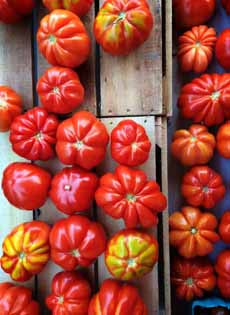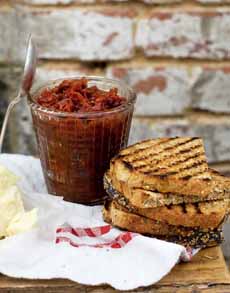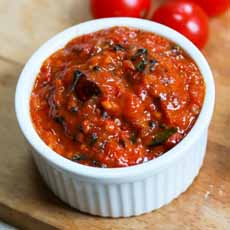TIP OF THE DAY: Easy Tomato Chutney
 [1] Turn summer tomatoes, ripe off the vine, into…
[3] This authentic Indian version has chili powder, garlic, garam masala and ginger. Here’s the recipe from Smart Cooky. |
August is the best “tomato month” of the year. Aside from eating them raw with just about anything, what else to do with the crop of summer tomatoes? Among your many options, make some tomato chutney. It’s a delicious summery treat to: In the following recipe, one pound of tomatoes doesn’t make a whole lot of chutney. Do a test batch—it’s an easy recipe—to decide how much you want to make. Since the chutney cooks up into a jam-like consistency, you can also use very ripe tomatoes that are often better priced. You can use one variety, or a combination of assorted tomatoes (including different colors). Ingredients Per Pound Of Tomatoes 1. PEEL and finely slice the onions; roughly chop the tomatoes; and de-seed and finely slice the chile. 2. PLACE all ingredients in a pot, season to taste and stir well to combine. Simmer for 30 to 40 minutes or until jammy. 3. POUR into a clean† jar and let cool. ________________ *If you want no heat at all, use red bell pepper. †Since this is not a recipe for canning, the jar doesn’t have to be sterilized. However, to ensure cleanliness, use one that has been run through the dishwasher. ‡You can play with accents such as basil, garlic, lemon or lime zest and other favorite flavors. WHAT IS CHUTNEY? Chutney is a spiced condiment, served as a side dish, that originated in India. Chatni is the Hindi word for strongly spiced. It is made of fruits or vegetables; and is typically served as an accompaniment to food (i.e., not as a spread). |
|
|
Fruit chutney consists of chopped fruit (tomato is a fruit), vinegar, spices and sugar cooked into a chunky sweet-tart-spicy mix. According to one explanation, it “blurs the Western distinction between preserves and pickles” [source]. Some of the most common Indian chutneys are made with coconut, mango, peanut, sesame or the ground herbs, such as coriander or mint. The spice level of chutney can range from mild to hot, and the consistency from a fine relish to a preserve or conserve. Historically, chutneys were only served by everyday folk on special occasions such as weddings. It was more of a staple for the wealthy. That’s because in the era before stoves, it was a time-consuming undertaking: The chutney was slowly cooked under the hot Indian sun over a period of several days, until it was deemed to have attained the right flavor and consistency. This method is still employed in modern India, in homes which do not have stoves. “Solar cooking” is even specified in recipes for those who do have them. Each region has its own recipes, using local ingredients. Simple spiced chutneys, similar in preparation to pickles, have been dated to 500 B.C.E. This method of preserving food was subsequently adopted by the Romans. Beginning in the late 17th century, fruit chutneys from India were shipped to European countries like England and France as luxury goods. These were largely mango chutneys in sticky syrups, packed into ceramic pots. European cooks made their own [affordable] versions, substituting peaches or melons for pricey imported mangoes. By the 18th century, chutneys made in England were exported to to colonies in colonies Australia and North America. By the 19th century, many chutneys were manufactured in India specifically for export to Europe—including Major Grey’s, perhaps the best-known brand in the U.S. The recipes of these exports conformed to British tastes rather than to Indian authenticity; that is to say, they were generally sweet and lacked the intense flavors, saltiness, or peppery heat preferred in India). Today, thanks to the growth of Americans of Indian ancestry, a wide variety of chutney is available in the U.S. Do try the savory varieties, such as cilantro and mint. They’re delicious—and sugar-free. Here’s more of the history of chutney. |
||




